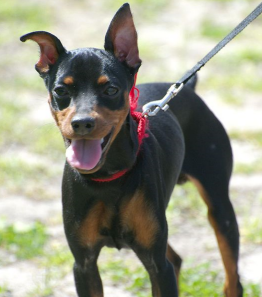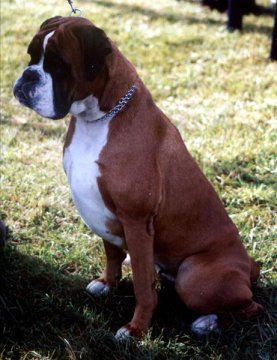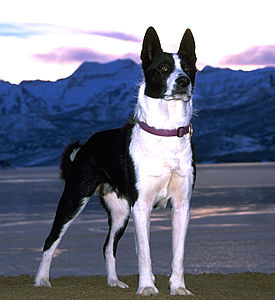 |
| Vital Statistics: |
| Place of Origin: France, Germany |
| Group: Sporting dog, Companion dog |
| Height: Standard-15 in. up, Miniature 10-15 in., Toy under 10 in. |
| Weight: Standard 45-70 lbs., Miniature 15-17 lbs., Toy 6-9 lbs. |
| Life span: Standard 11-12 yrs., Miniature & Toy 14-15 yrs. |
| Trainability: high |
| Good with children: yes |
| Good with other pets: yes |
The origin of the Poodle has been in dispute, whether is comes from France, Germany, Denmark or ancient Piedmont. The name is from the German word “Pudel” or “Pudelhound” which means splashing dog It was developed by the French to it current form.
What does the Poodle look like?
The three types of Poodle, Standard, Miniature and Toy are all very popular dogs. There is also a teacup size. In America, height and weight is as follows: Standard – over 15 inches tall and 45-70 lbs., Miniature – 10-15 inches tall and 15-17 lbs., Toy – less than 10 inches tall and 6-9 lbs. The Poodle has no undercoat. Its thick, curly hair sheds little and is hypoallergenic. Since the Poodle’s hair grows regularly, it must be clipped about every 6-8 weeks. Colors are solid black, grey, cream, apricot, brown and cafe au lait. Ears fall along the flat cheeks. The tail is usually docked and set high. Since the Poodle’s hair grows regularly, it must be clipped about every 6-8 weeks.
What is the Poodle’s temperament?
The Poodle is one of the most intelligent dogs. It seems to understand everything you say. The Poodle trains easily and willingly and performs in circuses. It is a sensitive breed that responds to kindness. Poodles are good with other dogs and pets. They should be socialized early with children. They are easy to housebreak. Poodles do well in apartments, but need that daily walk and if available, a place to run and play off lead.
What are the Poodles uses?
The Poodle was originally used as a water retrieving dog. The Standard size Poodle can be used as a guard dog. All sizes are loving and loyal companion dogs.
Possible Health Issues
Bloat/gastric torsion, Addison’s Disease, Cushing’s Disease, hypothyroidism, progressive retinal atrophy, cataracts, glaucoma, von Willebrand’s Disease
Smaller poodles have issues with patellar luxation, Legg-Calve-Perthes Disease
- Alaskan Klee Kai
- Bichon Frise
- Bichpoo
- Brussels Griffon
- Bull Terrier
- Bulldog
- Cardigan Welsh Corgi
- Cavalier King Charles Spaniel
- Chihuahua
- Chinese Crested
- Coton de Tulear
- Eurasier
- French Bulldog
- German Spitz (Giant, Standard, Toy)
- Hairless Khala
- Havanese
- Japanese Chin
- Japanese Chin Dog
- Keeshond
- Lhasa Apso
- Lowchen
- Maltese
- Mi Ki
- Miniature Pinscher
- Moscow Toy Terrier
- Norwegian Lundehund
- Papillon
- Pekingese
- Pomeranian
- Portuguese Water Dog
- Pug
- Sanshu
- Schipperke
- Schnorgi
- Shiba Inu
- Shih-Tzu
- Tibetan Spaniel
- Yorkshire Terrier
- American Cocker Spaniel
- Barbet
- Boulet Griffon
- Boykin Spaniel
- Bull Terrier
- Clumber Spaniel
- Curly-coated Retriever
- Dalmatian
- English Cocker Spaniel
- English Setter
- English Springer Spaniel
- Flat-coated Retriever
- German Shorthaired Pointer
- Golden Retriever
- Gordon Setter
- Harrier
- Irish Setter
- Irish Water Spaniel
- Kishu Inu
- Kooiker Hound (Kooikerhondje)
- Labrador Retriever
- Lagotto Romagnolo
- Landseer
- Mountain Cur
- Nova Scotia Duck Tolling Retriever
- Otterhound
- Picardy Spaniel
- Pudelpointer
- Redbone Coonhound
- Redtick Coonhound
- Rhodesian Ridgeback
- Spinone Italiano
- Stabyhoun
- Sussex Spaniel
- Telomian
- Treeing Tennessee Brindle
- Vizsla
- Weimaraner
- Welsh Springer Spaniel
- Wirehaired Pointing Griffon
- Wirehaired Styrian Mountain Hound
- Wirehaired Vizsla
- Airedale Terrier
- Beagle
- Bedlington Terrier
- Bluetick Coonhound
- Border Collie
- Border Terrier
- Bull Terrier
- Bulldog
- Bullmastiff
- Ca de Bou
- Cavalier King Charles Spaniel
- Clumber Spaniel
- Collie
- Curly-coated Retriever
- Dandie Dinmont Terrier
- English Cocker Spaniel
- English Foxhound
- English Setter
- English Springer Spaniel
- English Toy Terrier
- Flat-coated Retriever
- Golden Retriever
- Greyhound
- Harrier
- Jack Russell Terrier
- Lakeland Terrier
- Lancashire Heeler
- Llewellyn Setter
- Manchester Terrier
- Mastiff
- Norfolk Terrier and Norwich Terrier
- Old English Sheepdog
- Old English Terrier
- Otterhound
- Parson Russell Terrier
- Shetland Sheepdog
- Smooth and Wire-haired Fox Terrier
- Sussex Spaniel
- Welsh Terrier
- Whippet
- Wire Fox Terrier
- Yorkshire Terrier



